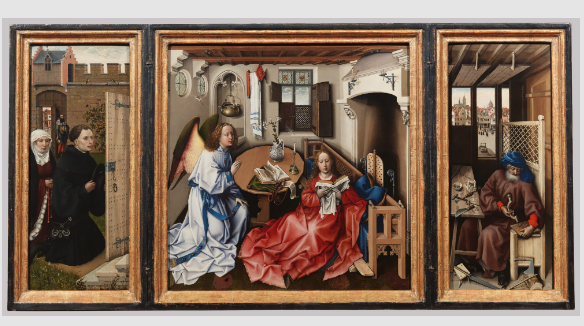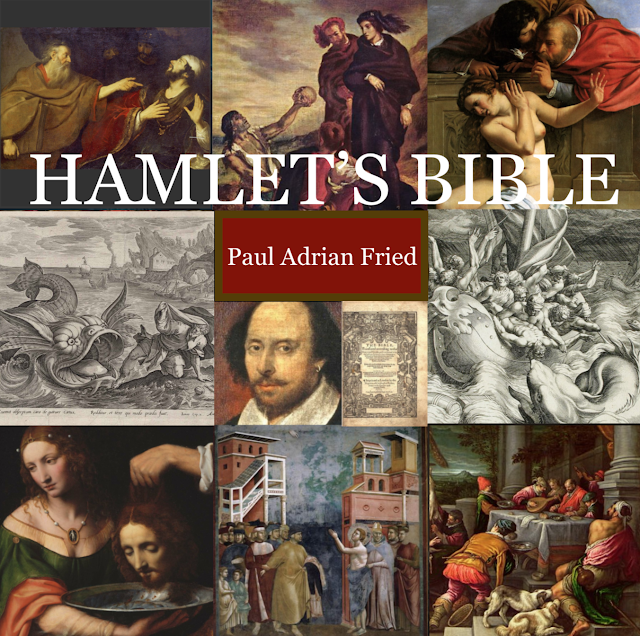Neglected Religious and Political Meanings of the Annunciation Allusion in Hamlet 3.1
To prepare Ophelia as bait for eavesdropping, Polonius in 3.1 tells her,
Read on this book,
[...]
[....] We are oft to blame in this,
[...] that with devotion's visage
And pious action we do sugar o'er
The Devil himself. (49-55)
So just look as if you’re devoted to reading, not bait for spying.
But why “devotion's visage / And pious action”? “The Devil”?
I’ve posted before about how Katharine Goodland (2006) [1] and Ruben Espinoza (2011) recognized that Polonius made Ophelia resemble a common image from old prayer books: the Virgin Mary is portrayed as reading a book of psalms when the angel Gabriel tells her that she is pregnant with Jesus (Lk 1: 26-38).
 [Robert Campin, Annunciation Triptych (Merode Altarpiece) in the MET museum (ca. 1427–32). Public domain. Image via Google Arts and Culture.]
[Robert Campin, Annunciation Triptych (Merode Altarpiece) in the MET museum (ca. 1427–32). Public domain. Image via Google Arts and Culture.]
In Catholic prayer, the "Hail Mary" says, “Holy Mary, mother of God, pray for us sinners....”
On seeing Ophelia, Hamlet says (aside), “in thy orisons (prayers) be all my sins remembered.”
Ophelia is no Virgin Mary, and Hamlet no Joseph or Gabriel. Yet the Annunciation and Nativity tales are not just about a god-become-human long ago.
Every pregnancy may be a transcendent experience, accompanied by fear, wonder, joy. And nations ruled by monarchs especially looked with expectation to the birth of a new heir - hopefully a new and benevolent monarch who might rule with mercy and justice in the image of the idealization of their Christian God.
In the Christian tale, King Herod the Great kills many infants to prevent a succession to an infant that the Magi predict will replace him. In Denmark, Claudius kills his brother to take the throne, succession moving sideways to brother (and murderer) instead of to the son, Prince Hamlet.
In England, too, succession moved sideways from Edward to Mary, then Elizabeth. Many were killed for religion, heresy, or treason in what may have resembled a Protestant-Catholic version of the back-and-forth rhythm of Greek revenge tragedy.
Hamlet’s letters express love for Ophelia; Ophelia has similar feelings. They might have wed and produced an heir, but are prevented by the circumstance of the king's murder, and by her father who, some say, is a character based in part on Elizabeth’s Lord Treasurer, William Cecil.
So the scene offers an Annunciation image only to deceive, and an echo of Suzannah and the Corrupt (and spying) Elders (Daniel 13), with Ophelia as willing bait, complicit with the spies. (Cecil and the monarch can be seen as the corrupt elders.)
But just as a Cecil-like Polonius abuses the remembered image of the Annunciation to trick Hamlet, Elizabeth promoted herself as “Virgin Queen” (playing off the idea of the Virgin Mary), figuratively married to her country - but with no heir.
In this light, Hamlet’s “get thee to a nunnery” may be an angry imperative that Ophelia should be consistent with her father’s (Cecil’s?) manipulation of her pious “visage”: Go and become the holy and prayerful image that your father wants you to seem for purposes of his deception. (“I know not ‘seems’.”)
In a land where Marian devotion was not only discouraged but eliminated from liturgy, and images destroyed, Hamlet 3.1 shows how religious tropes like the Annunciation can be abused, and holds a mirror up for all the subjects of England’s (allegedly?) Virgin Queen, Elizabeth I.
~~~~~~~~~~~~~~~~~~~~~~~~
NOTES:
[1] Katharine Goodland, Female Mourning and Tragedy in Medieval and Renaissance English Drama, Routledge, 2006:
https://www.routledge.com/Female-Mourning-and-Tragedy-in-Medieval-and-Renaissance-English-Drama-From/Goodland/p/book/9781138275638
[2] Ruben Espinoza, Masculinity and Marian Efficacy in Shakespeare's England. Routledge, 2011.
https://www.routledge.com/Masculinity-and-Marian-Efficacy-in-Shakespeares-England/Espinosa/p/book/9781138268111
[3] As I've said in a previous post on the topic, I owe this insight regarding the eavesdropping scene as an echo of Suzannah and the Elders (Dan 13) to Frank Ardolino who offers parallel insights about the eavesdropping scene in The Spanish Tragedy, as explained in his book, Apocalypse & Armada.
Frank Ardolino. Apocalypse & Armada in Kyd's Spanish Tragedy. Sixteenth Century Essays and Studies 29. Kirksville, Mo.: Sixteenth Century Journal Publishers, 1995.
- And note: The Suzannah tale of Daniel 13 only appears in Catholic and Orthodox bibles, not Protestant, which considered Daniel 13 an apocryphal book.
~~~~~~~~~~~~~~~~~~~~~~~~
Disclaimer: If and when I quote or paraphrase bible passages in many of my blog posts, I do not intend to promote any religion over another, nor am I attempting to promote religious belief in general; only to point out how the Bible may have influenced Shakespeare, his plays, and his age.
~~~~~~~~~~~~~~~~~~~~~~~~
Thanks for reading! My current project is a book tentatively titled Hamlet’s Bible, about biblical allusions and plot echoes in Hamlet.
Below is a link to a list of some of my top posts (“greatest hits”), including a description of my book project (last item on the list):
https://pauladrianfried.blogspot.com/2019/12/top-20-hamlet-bible-posts.html
I post every week, so please visit as often as you like and consider subscribing.

Read on this book,
[...]
[....] We are oft to blame in this,
[...] that with devotion's visage
And pious action we do sugar o'er
The Devil himself. (49-55)
So just look as if you’re devoted to reading, not bait for spying.
But why “devotion's visage / And pious action”? “The Devil”?
I’ve posted before about how Katharine Goodland (2006) [1] and Ruben Espinoza (2011) recognized that Polonius made Ophelia resemble a common image from old prayer books: the Virgin Mary is portrayed as reading a book of psalms when the angel Gabriel tells her that she is pregnant with Jesus (Lk 1: 26-38).
 [Robert Campin, Annunciation Triptych (Merode Altarpiece) in the MET museum (ca. 1427–32). Public domain. Image via Google Arts and Culture.]
[Robert Campin, Annunciation Triptych (Merode Altarpiece) in the MET museum (ca. 1427–32). Public domain. Image via Google Arts and Culture.]In Catholic prayer, the "Hail Mary" says, “Holy Mary, mother of God, pray for us sinners....”
On seeing Ophelia, Hamlet says (aside), “in thy orisons (prayers) be all my sins remembered.”
Ophelia is no Virgin Mary, and Hamlet no Joseph or Gabriel. Yet the Annunciation and Nativity tales are not just about a god-become-human long ago.
Every pregnancy may be a transcendent experience, accompanied by fear, wonder, joy. And nations ruled by monarchs especially looked with expectation to the birth of a new heir - hopefully a new and benevolent monarch who might rule with mercy and justice in the image of the idealization of their Christian God.
In the Christian tale, King Herod the Great kills many infants to prevent a succession to an infant that the Magi predict will replace him. In Denmark, Claudius kills his brother to take the throne, succession moving sideways to brother (and murderer) instead of to the son, Prince Hamlet.
In England, too, succession moved sideways from Edward to Mary, then Elizabeth. Many were killed for religion, heresy, or treason in what may have resembled a Protestant-Catholic version of the back-and-forth rhythm of Greek revenge tragedy.
Hamlet’s letters express love for Ophelia; Ophelia has similar feelings. They might have wed and produced an heir, but are prevented by the circumstance of the king's murder, and by her father who, some say, is a character based in part on Elizabeth’s Lord Treasurer, William Cecil.
So the scene offers an Annunciation image only to deceive, and an echo of Suzannah and the Corrupt (and spying) Elders (Daniel 13), with Ophelia as willing bait, complicit with the spies. (Cecil and the monarch can be seen as the corrupt elders.)
But just as a Cecil-like Polonius abuses the remembered image of the Annunciation to trick Hamlet, Elizabeth promoted herself as “Virgin Queen” (playing off the idea of the Virgin Mary), figuratively married to her country - but with no heir.
In this light, Hamlet’s “get thee to a nunnery” may be an angry imperative that Ophelia should be consistent with her father’s (Cecil’s?) manipulation of her pious “visage”: Go and become the holy and prayerful image that your father wants you to seem for purposes of his deception. (“I know not ‘seems’.”)
In a land where Marian devotion was not only discouraged but eliminated from liturgy, and images destroyed, Hamlet 3.1 shows how religious tropes like the Annunciation can be abused, and holds a mirror up for all the subjects of England’s (allegedly?) Virgin Queen, Elizabeth I.
~~~~~~~~~~~~~~~~~~~~~~~~
NOTES:
[1] Katharine Goodland, Female Mourning and Tragedy in Medieval and Renaissance English Drama, Routledge, 2006:
https://www.routledge.com/Female-Mourning-and-Tragedy-in-Medieval-and-Renaissance-English-Drama-From/Goodland/p/book/9781138275638
[2] Ruben Espinoza, Masculinity and Marian Efficacy in Shakespeare's England. Routledge, 2011.
https://www.routledge.com/Masculinity-and-Marian-Efficacy-in-Shakespeares-England/Espinosa/p/book/9781138268111
[3] As I've said in a previous post on the topic, I owe this insight regarding the eavesdropping scene as an echo of Suzannah and the Elders (Dan 13) to Frank Ardolino who offers parallel insights about the eavesdropping scene in The Spanish Tragedy, as explained in his book, Apocalypse & Armada.
Frank Ardolino. Apocalypse & Armada in Kyd's Spanish Tragedy. Sixteenth Century Essays and Studies 29. Kirksville, Mo.: Sixteenth Century Journal Publishers, 1995.
- And note: The Suzannah tale of Daniel 13 only appears in Catholic and Orthodox bibles, not Protestant, which considered Daniel 13 an apocryphal book.
~~~~~~~~~~~~~~~~~~~~~~~~
Disclaimer: If and when I quote or paraphrase bible passages in many of my blog posts, I do not intend to promote any religion over another, nor am I attempting to promote religious belief in general; only to point out how the Bible may have influenced Shakespeare, his plays, and his age.
~~~~~~~~~~~~~~~~~~~~~~~~
Thanks for reading! My current project is a book tentatively titled Hamlet’s Bible, about biblical allusions and plot echoes in Hamlet.
Below is a link to a list of some of my top posts (“greatest hits”), including a description of my book project (last item on the list):
https://pauladrianfried.blogspot.com/2019/12/top-20-hamlet-bible-posts.html
I post every week, so please visit as often as you like and consider subscribing.

As usual, Paul, insightful. Your questions, beginning with these: "But why “devotion's visage / And pious action”? “The Devil”?" and the others within your entry challenge my critical-thinking skills.
ReplyDeleteThank you.
You're always welcome, Michael!
Delete